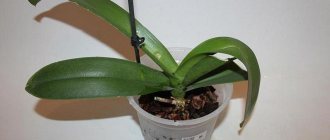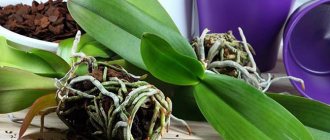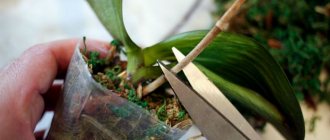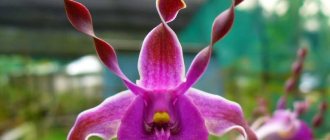Author: Tamara Altova. September 14, 2018
Category: Houseplants.
The orchid appeared on our windowsills not so long ago, but has already gained popularity due to its beauty and unpretentious character. Caring for an orchid is not difficult, but sometimes the plant has problems, and you must know how to help it in one case or another. Our readers often ask why orchid leaves turn yellow, and we would like to answer this question and share with you information on how to correct this problem and how to prevent it from occurring in the future.
What happens to a flower if it is transplanted?
Experts say that replanting an orchid is stressful . It is quite natural that the plant will be sick at first, and the growth of the root system and leaves is also possible. And the gardener’s task is to make this period easier for the flower.
Important : The best time to transplant an orchid is spring, since it is in spring that the roots and leaves of the plant begin to gain strength and grow vigorously.
It is at this time of year that the adaptation period of the flower to the new pot and substrate will be most successful (read more about choosing a pot and soil here). But you should not perform any manipulations with the orchid during flowering: it can shed all the flowers and buds. Such measures should be resorted to in extreme cases, when the entire plant is in danger of death.
Read more about whether it is possible to transplant a beauty when it has released an arrow, read here.
Excessive moisture in the substrate - and as a result, yellowing of the foliage
Most often, leaf diseases occur for this reason. Beginning flower lovers express their concern through watering. The harm from such “care” is obvious - lack of oxygen at the roots, proliferation of putrefactive bacteria. More experienced orchid breeders warn about the danger of determining the moisture content of the substrate by the top layer. The bark on the surface dries out very quickly, but deeper the planting mixture is still quite wet.
If the orchid is growing in an opaque pot, use a wooden stick. It is placed in the substrate near the rim of the pot. After a few minutes, the stick needs to be removed. A dry splinter will indicate that watering is necessary, and a wet splinter will warn against excessive watering. After some time, you can determine the need for watering by the weight of the pot. The lighter the pot, the less moisture in the substrate.
You can understand that an orchid’s leaves are turning yellow due to excessive watering by the following signs:
- color changes throughout the entire plant, not just the lower leaves;
- black spots can be seen on the leaves;
- leaves become soft and moist;
- the roots have darkened and turned black;
- An orchid growing in a pot can be easily removed from the substrate.
What to do if the orchid’s leaves turn yellow because the substrate is too wet? The plant needs to be urgently transplanted into another substrate. The roots of such a plant need to be given special attention. They need to be trimmed to healthy tissue, and the sections should be treated with charcoal powder or ground cinnamon.
Advice! All orchids should be watered and sprayed only with soft water. You can neutralize the hardness of tap water by adding up to 20% peat to the substrate.
An orchid planted after such an operation needs to reduce watering and spray it more often with soft, demineralized water. It will be useful to create a greenhouse around it that maintains constant air humidity.
The quality of irrigation water plays a very important role in the life of any orchids. For irrigation, it is necessary to use soft water with a minimum amount of dissolved salts, slightly acidic. Orchid roots consume a minimal amount of salts, the excess appears on the surface of the substrate in the form of a white coating, and the soil becomes covered with a coating of salt. The soil needs to be replaced.
You can try to restore the saline substrate by washing it with a large amount of distilled water used for car batteries. An orchid planted in a fresh substrate is fertilized through the leaves - by wiping them with a weak solution of fertilizers.
How to care for a plant that has undergone this procedure?
An orchid in a stressful state requires increased attention , as well as care and attention. But you shouldn’t be too zealous: a capricious flower may not “understand” overprotection. In order for the flower recovery period to be successful, after transplantation the plant needs to create an atmosphere of peace so that it can recover from the stress it has experienced: the orchid is placed in a shaded room, without being moved from place to place, and watered moderately according to a certain scheme.
What to do to prevent orchid leaves from turning yellow?
If the problem is improper care of the orchid, then you need to establish a healthy routine as quickly as possible. When the problem is a fungus or infection, quickly remove the damaged fragments and treat the plant with fungicides. But if the problem is a virus or advanced root rot, unfortunately, it is better to destroy the orchid.
Photo: domashniecvety.ru
Did you like the post? Subscribe to our channel in Yandex.Zen, it really helps us in our development!
Step-by-step instructions for care at home
- Immediately after transplantation, the orchid should be placed in a room with diffused lighting for 7 to 10 days. In the room it cannot be moved from place to place, but you need to choose one permanent position. Experienced florists advise: it is better if the flower is located on the eastern window. Direct sunlight on the leaves of the plant should be avoided; for this, the window can be covered with a translucent matte film.
- Pay attention to the temperature regime: the thermometer in the room should not rise above +20C-+22C.
- The first watering after transplantation must be carried out after 4 - 5 days, the next - no earlier than 14 days. Recommended water temperature is +35C-+40C.
The flower needs this time in order for the damage that the flower received when moving it to another container to heal. And also such a technique will make it possible to reduce the risk of pathogenic microorganisms entering the root system , which will certainly cause epiphyte disease.
Watering
There are several ways to water an orchid. Experienced gardeners advise that the first watering after replanting should be done with a shower, thereby creating something similar to a tropical downpour. For this:
The flower is placed in a bath and a stream of water is directed at it at a temperature slightly higher than room temperature.- After this, the plant remains in the bath for 15 - 20 minutes to drain excess water.
- After this procedure, the leaves must be wiped with a napkin.
You can also water the orchid by immersing the pot in a basin of water , then it enters the substrate through holes in the bottom and walls of the container. Another way is to water with a thin stream from a watering can until water begins to flow out of the holes. An important condition is to be sure to drain all excess water from the pot!
It is recommended to spray the leaves daily with warm boiled water from a spray bottle, which helps speed up the healing process of wounds received during transplantation. In this case, be sure to ensure that drops of water do not remain in the axils of the leaves. The average duration of this procedure is 1 month. The preferred time for spraying is early morning. If the weather is hot, then the number of sprays per day can be increased to three.
A little more about watering. For orchids, you should use only soft or moderately hard water with an acidity level of pH5 . The observation of the grower can help determine these indicators (just look at the layer of scale in the kettle: the larger it is, the higher the hardness) and indicator strips. For the latter, you should go to a specialized flower shop, where you can buy oxalic acid, which in a ratio of 1/8 tsp. 5 liters of water will help cope with hardness.
We recommend watching a video about the first watering of an orchid after planting:
Top dressing
Since the new substrate is rich in nutrients, experienced gardeners recommend feeding the orchid for the first time no earlier than a month later. In addition, the root system, injured during transplantation, cannot fully absorb all nutrients, which can lead to the creation of unfavorable microflora in the pot.
For feeding, it is better to use complex preparations intended only for orchids and purchased at a flower shop. For example, “Kemira Lux” (1g per 1 liter of water) or “Bona Forte” (10 ml per 1.5 liter).
In any case, it will not be superfluous to re-read the instructions for these fertilizers. The resulting liquid is watered over the orchid until the water saturates the substrate and begins to pour into the pan. Fertilizing is done during the period of active plant growth, that is, when a new leaf is formed.
Leaf senescence is not a reason to panic
One or even two yellowed leaves on an orchid are not a cause for great concern. This may be the natural process of leaf aging. The leaf of each plant has its own lifespan. The replacement of leaves occurs gradually. In common orchids such as cattleya or paphiopedilum, the lower leaves turn yellow and fall off. Less commonly, two leaves may turn yellow and fall off. In orchids from the genus Dendrobium, the bulbs may remain completely without leaves. In this case, no measures need to be taken; this is a natural process; the old leaf turns yellow, dries out completely and falls off on its own. You should not help the plant in this process; you should not cut or tear off the leaves.
Important! Forcibly cutting off the yellowed parts can injure the orchid, leaving an open wound.
In this case, yellowing of the leaves occurs very quickly. The leaf turns yellow in 1–4 days. Much depends on the age of the flower. The leaves themselves remain on the plant for several years, after which they fall off. This is as normal as autumn leaves falling.
Bacterial spot
There are other reasons why orchid leaves turn yellow. Have the leaves turned yellow sharply and unevenly, and then lost their elasticity and wrinkled? Bacterial spot is most likely to blame. It can also be recognized by characteristic wounds on the surface of the leaf from which liquid is released. In this case, the orchid must be quarantined and treated: cut off the affected areas, and treat the cut areas with an antiseptic, for example, iodine. If new spots appear after pruning, you need to use one of the special preparations against bacterial spotting.
The flower cannot be moved to healthy pets until it is known for sure that the disease will not return.
When there's too much sun
For the plant, you need to choose a place in the room where there will be a lot of diffused sunlight.
In winter, a sunny windowsill will be very suitable for cultivating orchid plants . But from May to September, a sunny windowsill can threaten its guests with severe overheating and sunburn.
It should be noted that burns cannot be treated, and the plant looks less aesthetically pleasing. In addition, damaged areas on the leaves do not participate in photosynthesis.
be moderately moist in the summer , and it is better to cover the windows with foil or white paper to create shade from the bright sun.
Signs of plant overheating
Main signs of overheating :
- Loss of turgor in the leaf mass;
- The roots stop absorbing moisture and therefore the flower’s nutrition stops;
- Leaves become : Flabby;
- Yellow;
- Withered.
All changes to the plant occur in hot weather within 4-6 hours.
How to eliminate the influence of bright sun on an orchid?
If the gardener is sure that his window sill is not suitable for orchids in the summer, he should cover the windows with protection and move the flowers deeper into the room.
On the sunny side, the window must be closed to allow the orchids to rest.
This will help save the collection from overheating in the summer. It is also worth carefully monitoring the condition of the soil, which should not dry out completely.
IMPORTANT! The soil should always be moderately moist in hot weather. Then its evaporation will help the foliage survive this difficult summer period for them.
Brief information
Indoor orchids belong to a large family of plants called Orchids. In their natural environment, they live mainly in tropical forests with a hot climate, high humidity and prolonged rainfall. Almost all decorative orchids in our country are bred from the phalaenopsis orchid, which prefers to settle on trees and rocks. In temperate climates, representatives of this family are not so common; for example, in Russia there are just over 400 species. However, breeders have developed a huge variety of hybrid ornamental varieties that can be grown in greenhouses or at home. But for them, you need to try to create conditions that are as close to natural as possible.
Why do orchid leaves turn yellow? The leaves of any plant are an indicator of health. And if such an alarming sign appears, then you need to look for the reason.
Closeness
The problem may be due to the fact that the pet has long outgrown its “apartment” and needs a transplant. In an overgrown plant, the roots are compressed and severely deformed, so they cannot provide nutrients to the leaves, which is why they suffer. The solution is an emergency transplant into a container that is 2-3 cm larger in diameter than the previous one. A pot that is too large is not needed - if there is an abundance of substrate, water begins to linger and the roots rot.
Yellowness and dryness of roots
There is another answer to the question of why orchid leaves turn yellow. Leaves can suffer not only from excess moisture, but also from its lack. This can be determined by the dryness of the roots. To correct the situation, you need to organize a competent watering regime. The tropical flower is watered abundantly, 2 times a week, but excess moisture should drain into the pan. During the dormant phase, plants are watered no more than once a week.
Pests and diseases are another reason for yellowing leaves
Another reason for yellowing leaves is poor health of the plant caused by pests or diseases. The relationship between these two misfortunes is direct. Pests that appear on the plant infect it with infectious diseases, and an orchid weakened by insects cannot fully resist viruses and bacteria. The affected orchid wilts, its leaves turn yellow and wither.
Most often found on orchids:
- spider mite - its presence is indicated by the appearance of a barely noticeable cobweb on the leaves or shoots. Remove it with hot (40–45 C) water. The washed flower is kept under cover in an atmosphere of high humidity for up to three days. Of the chemicals used, “Neoron” or “Tiofos”;
- aphid - settles on the back side of the leaf. They spread a fungal infection. Traces of aphids on the plant are a sticky coating. You can fight aphids with any alkaline solution - infusion of ash or laundry soap. In more advanced cases, Fitoverm or Biotlin can be used for residential premises.
Orchid diseases can also cause leaves to turn yellow. A healthy plant receives a bacterial, viral or fungal infection from a sick plant through insects - pests or care tools. All new plants should be quarantined for two weeks, separately from other residents of the home greenhouse.
The main signs of infection are round spots on the leaves, stem or peduncle. Later, dents or bumps appear in place of the spots. In the early stages of the disease, fungicides will help control it. In advanced cases, more radical measures are used - damaged parts of plants are removed down to healthy tissue, and the sections are disinfected.
Stress
The exotic beauty cannot stand change. Any changes in microclimate associated with moving to another place or changing seasons lead to a state of stress, which is reflected in the foliage. Therefore, you need to move a pot with a flower to a new place gradually: it is placed for several hours a day so that the plant gets used to the new conditions.
This is the main list of reasons why orchid leaves turn yellow. Plant leaves are the first to respond to environmental changes, even the most minor ones. And an attentive florist will quickly correct the situation.
But sometimes it is more difficult to determine the source of the problem. If all of the above cases do not apply, then most likely we are talking about a fungal or bacterial infection or pest infestation.
Incorrect transplant
Often, flower growers, after purchasing, rush to transplant an orchid into a new pot, and even choose a larger one. This is a big mistake. Epiphytes do not need a lot of space and substrate. You can simply hang them, and wrap the roots in moss and moisten it regularly.
After replanting in good soil and in a pot of suitable size, one leaf may turn yellow. This is called adaptation. If several Phalaenopsis leaves turn yellow or brown, inspect the roots immediately. You may need to replant the flower back into a smaller pot.
You will be interested to know: Why do cucumbers bloom with barren flowers: what to do, what to water with, how to get rid of barren flowers











